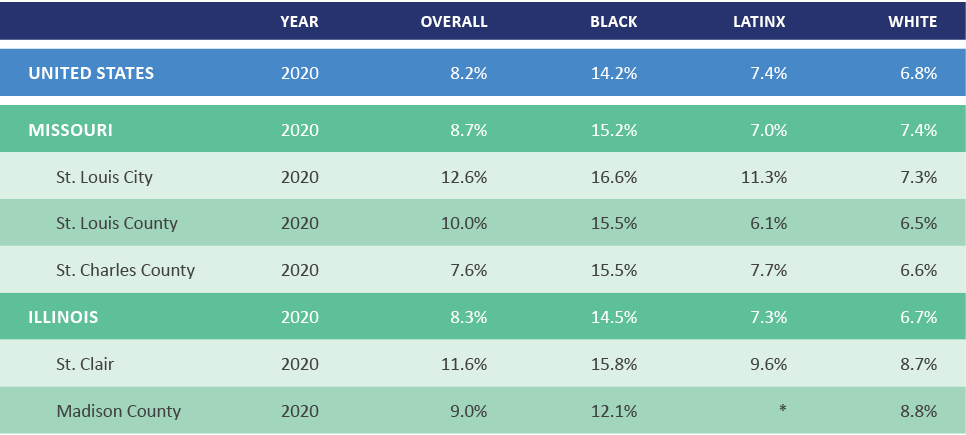Equity Data
Maternal & Child Health
Percent of Babies Born with Inadequate Prenatal Care
Prenatal care is essential to ensuring the best possible outcomes for both the mother and child during pregnancy and after the baby is born. Prenatal care plays a critical role in decreasing adverse birth outcomes, such as preterm births and low birthweight births, which can have life-long effects on overall child well-being. To give every child the best start in life it is imperative that all women have access to comprehensive, affordable preconception and prenatal care.


US: Centers for Disease Control and Prevention. Reproductive Health. Accessed at https://www.cdc.gov/reproductivehealth/data_stats/index.htm. MO: Missouri Department of Health & Senior Services. Missouri Information for Community Assessment (MICA). Accessed at http://health.mo.gov/data/mica/MICA/. 2020 data. IL: Illinois Department of Public Health. Freedom of Information Act request. 2020 data.
Percent of Babies Born Preterm
Infants born preterm have higher rates of immediate and long-term health complications, as well as higher rates of lifelong disability. The underlying causes of premature birth are poorly understood, particularly as it pertains to the persistent racial disparities observed in birth outcomes, with Black women experiencing preterm birth at rates higher than every other race and ethnicity.

US: Centers for Disease Control and Prevention. Reproductive Health. Accessed at https://www.cdc.gov/reproductivehealth/data_stats/index.htm. MO: Missouri Department of Health & Senior Services. Missouri Information for Community Assessment (MICA). Accessed at http://health.mo.gov/data/mica/MICA/. 2020 data. IL: Illinois Department of Public Health. Freedom of Information Act request. 2020 data.
Percent of Babies Born with Low Birthweight
Infants born at a low birthweight are at an increased risk of many serious health conditions, as well as an increased rate of infant mortality. Additionally, infants born at a low birthweight are at an increased risk of adverse effects to their long-term well-being, effecting everything from their kindergarten readiness to high school completion. The most effective way to reduce the number of infants born with low birthweight is to focus on preventative measures and to address the social determinants of health that can influence the number of low birthweight births in a community.

US: Centers for Disease Control and Prevention. Reproductive Health. Accessed at https://www.cdc.gov/reproductivehealth/data_stats/index.htm. MO: Missouri Department of Health & Senior Services. Missouri Information for Community Assessment (MICA). Accessed at http://health.mo.gov/data/mica/MICA/. 2020 data. IL: Illinois Department of Public Health. Freedom of Information Act request. 2020 data.
Infant Mortality Rate per 1,000 Live Births
The Infant Mortality Rate is frequently used as a key measure of the overall health, well-being and quality of life of the people living in a given community. It is an important indicator to monitor, particularly since a high Infant Mortality Rate can be indicative of underlying problems in a community, such as poor access to prenatal care, violence in the community, and a lack of safe, affordable, quality early child care options. Furthermore, differences between infant mortality rates can point to inequities, past and present, within a community.

US: Centers for Disease Control and Prevention. Reproductive Health. Accessed at https://www.cdc.gov/reproductivehealth/data_stats/index.htm. MO: Missouri Department of Health & Senior Services. Missouri Information for Community Assessment (MICA). Accessed at http://health.mo.gov/data/mica/MICA/. 2020 data. IL: Illinois Department of Public Health. Freedom of Information Act request. 2020 data.
Children’s Data
Vision for Children at Risk informs the community with data and information on child well-being in the St. Louis area, builds and drives collaboration and strategic action for children, and advocates for policies and investment in children that support child well-being.




















